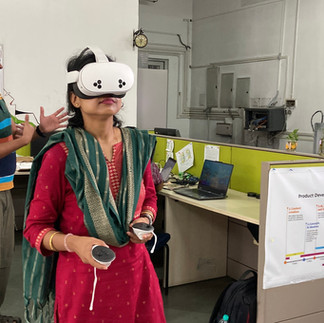Unlocking Science: Insights from Gyan Dhara's 2-Day Workshop with Science Teachers in Assam!
- Keyur Sorathia
- Aug 5
- 4 min read
We recently hosted a pivotal two-day workshop in Guwahati, bringing together nine dedicated science teachers from Adarsha Vidyalayas across Assam. Our goal? To gain invaluable, first-hand insights into the science concepts in Grades 8 and 9 that students consistently find challenging, and to inform the design of truly impactful, concept-driven learning modules.
The Challenge: Why Science Feels Hard
Our discussions with these experienced educators revealed several recurring obstacles that make certain topics particularly tough for students. It's not about a lack of interest, but rather how these concepts are currently structured and presented. Here are the key pain points identified:
Invisible Processes and Abstract Systems: Many concepts, especially in physics-heavy topics like Gravitation, Motion, Force, and Sound, are difficult to visualise as they involve unseen forces or particle behaviour. For instance, students struggle to picture how sound waves propagate or the internal mechanics of buoyant force.
Terminology Overload: Students often face a deluge of technical language, making it hard to differentiate subtly distinct terms like 'mass vs. weight' or 'valency vs. valence electrons'.
Lack of Logical Sequencing: Teachers highlighted that topics are sometimes taught out of a pedagogically sound order, leading to confusion. For example, understanding valency is crucial before chemical formulae, but often the reverse occurs.
Fear of Numericals: The integration of mathematics, particularly in chapters like Motion and Work & Energy, can cause significant cognitive overload and math-phobia for many students.
Retention Issues in Biology: Topics like 'Fundamental Unit of Life' and 'Tissues' suffer from memorisation challenges due to unfamiliar terms and a lack of strong visual anchors, making it hard for students to internalise structural and functional details.
Difficulty with Practicals and Visualisation: Many chemical reactions or phenomena like the Tyndall effect are challenging to demonstrate safely or effectively in typical classrooms, leading to rote learning rather than true understanding.
Our Collaborative Approach
To get to the heart of these challenges, teachers engaged in a two-phase session. First, an individual prioritisation activity using post-its helped quantify common perceptions of difficulty. This was followed by moderated deep-dive discussions, where teachers shared their invaluable classroom experiences, explored misconceptions, and discussed current teaching methods and their limitations. This comprehensive approach allowed us to identify specific subtopics that consistently confuse students and understand the nature of these learning difficulties.
Through this process, a final list of 10 priority chapters in Grade 9 and 9 chapters in Grade 8 was established, highlighting specific subtopics and their associated learning difficulties.
A Vision for Immersive Learning: The Power of VR
These insights are not just diagnostic; they are directional, pointing us towards innovative solutions. We believe the future of science education lies in visual-first, interactive, and scaffolded learning, especially for those elusive concepts. The workshop solidified our commitment to developing XR-based science learning modules.
To validate this approach, teachers also experienced several Virtual Reality (VR) modules firsthand. Despite being a first exposure to VR for most, the feedback was overwhelmingly positive!. Modules like Chemistry Lab VR and Zero Gravity Room were highly appreciated for their visual clarity and immersive engagement. As one teacher exclaimed, "Acchha laga… alag duniya!" (It felt good... a different world!). Teachers immediately recognised the potential for students, noting that they would find it even easier due to their familiarity with gaming.
Our recommendations for future content development are clear:
Focus on Conceptually Challenging Subtopics: Rather than full chapters, we will target specific areas like buoyancy, displacement reactions, or sound wave behaviour.
Prioritise Pedagogical Flow: Content design will follow a logical learning sequence over textbook order. For instance, teaching Motion before Force, or Valency before Chemical Formulae.
Target Invisible Phenomena with Visuals: We will use layered module designs to demystify micro-level particle behaviour (e.g., states of matter, evaporation, electrolysis), systems that require sequencing (e.g., nitrogen cycle, energy transformation), and spatial concepts (e.g., moon phases, flame zones).
Incorporate Interactive Cause-Effect Logic: Students won't just observe; they will manipulate variables and see the immediate impact, such as changing surface textures to observe changes in friction.
Integrate with Classroom Teaching: Our modules will serve as extensions of classroom instruction, adopting a concept-first approach where numericals follow intuitive understanding.
Support Differentiated Learning: Through multi-modal elements (audio, visual, interactive), language scaffolding, and relatable, real-life examples, we aim to cater to diverse learning needs.
Next Steps on Our Journey
Based on these invaluable findings, the Gyan Dhara team is now meticulously selecting five high-impact science topics from each grade (8 and 9) for dedicated VR development. Our selection process is guided by three core VR justification criteria:
Is the concept difficult to grasp through 2D visuals or text? Is a full sensory experience beneficial?
Does it involve phenomena that can’t be directly observed or are hard to recreate physically or contextually?
Does the topic require hands-on manipulation, changing variables, or practice to understand?
This structured approach will ensure that our VR modules will truly leverage the unique strengths of immersive technology to address the most significant learning hurdles in science. We are incredibly excited about this journey and look forward to sharing our progress as we bring science to life for students across Assam!


















Comments